Dundervelt Family Trust: Liabilities, Remedies, and Case Analysis
VerifiedAdded on 2023/01/16
|8
|2254
|79
Report
AI Summary
This report analyzes the Dundervelt Family Trust case, involving trustees Adrianna, Bridget, and Conrad, and accountant Edith. The case examines a breach of trust where Edith advises the sale of trust-owned properties for her personal gain, with Conrad's knowledge and involvement. The report details the liabilities of each party, including breaches of fiduciary duty, conflict of interest, and failure to act in good faith. It assesses the duties of care, investment powers, and the importance of balancing income and capital. The report concludes by outlining the remedies available to the parties, such as compelling trustees to fulfill their duties, seeking financial redress for losses, and potentially removing or suspending trustees. The analysis emphasizes the legal framework governing trusts and the consequences of failing to adhere to these regulations.
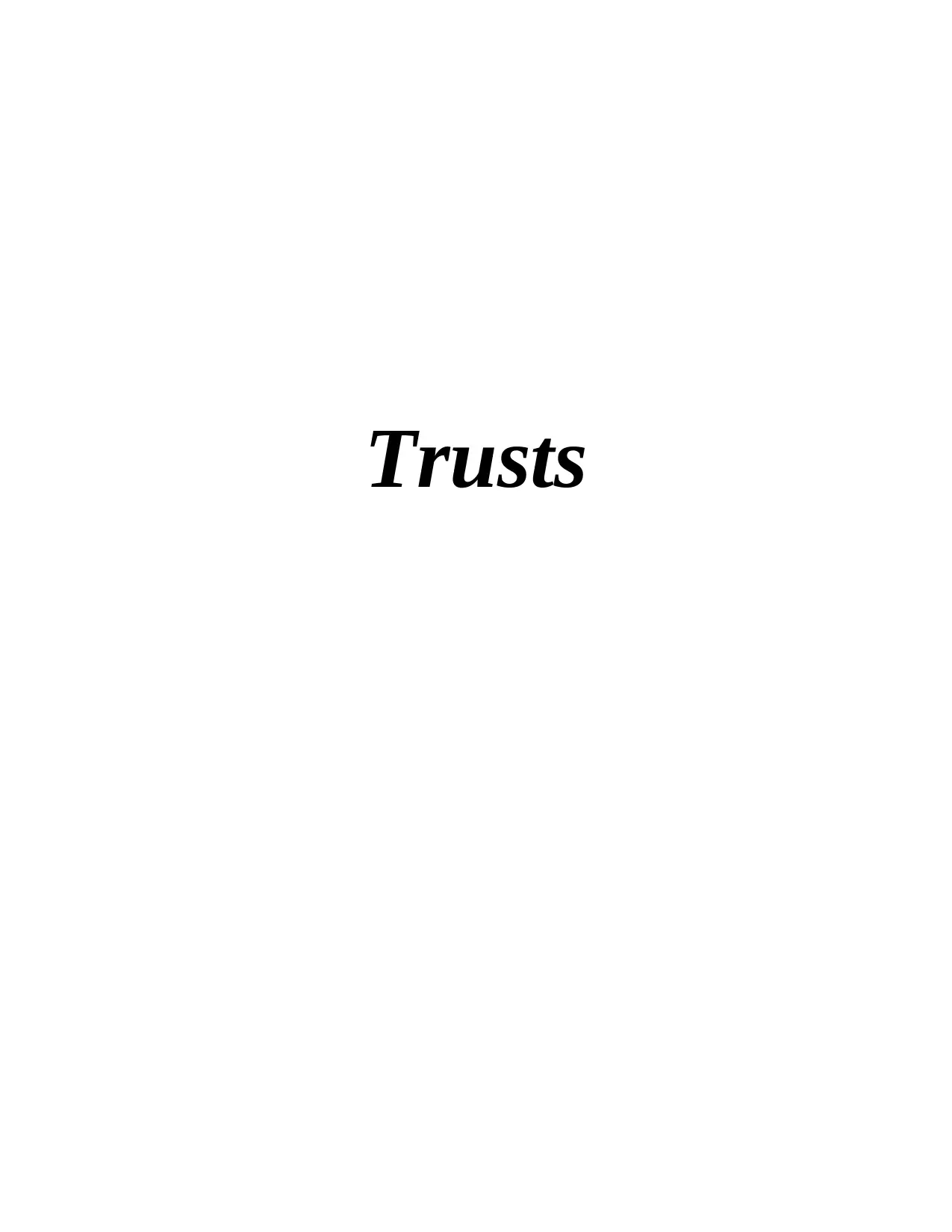
Trusts
Paraphrase This Document
Need a fresh take? Get an instant paraphrase of this document with our AI Paraphraser
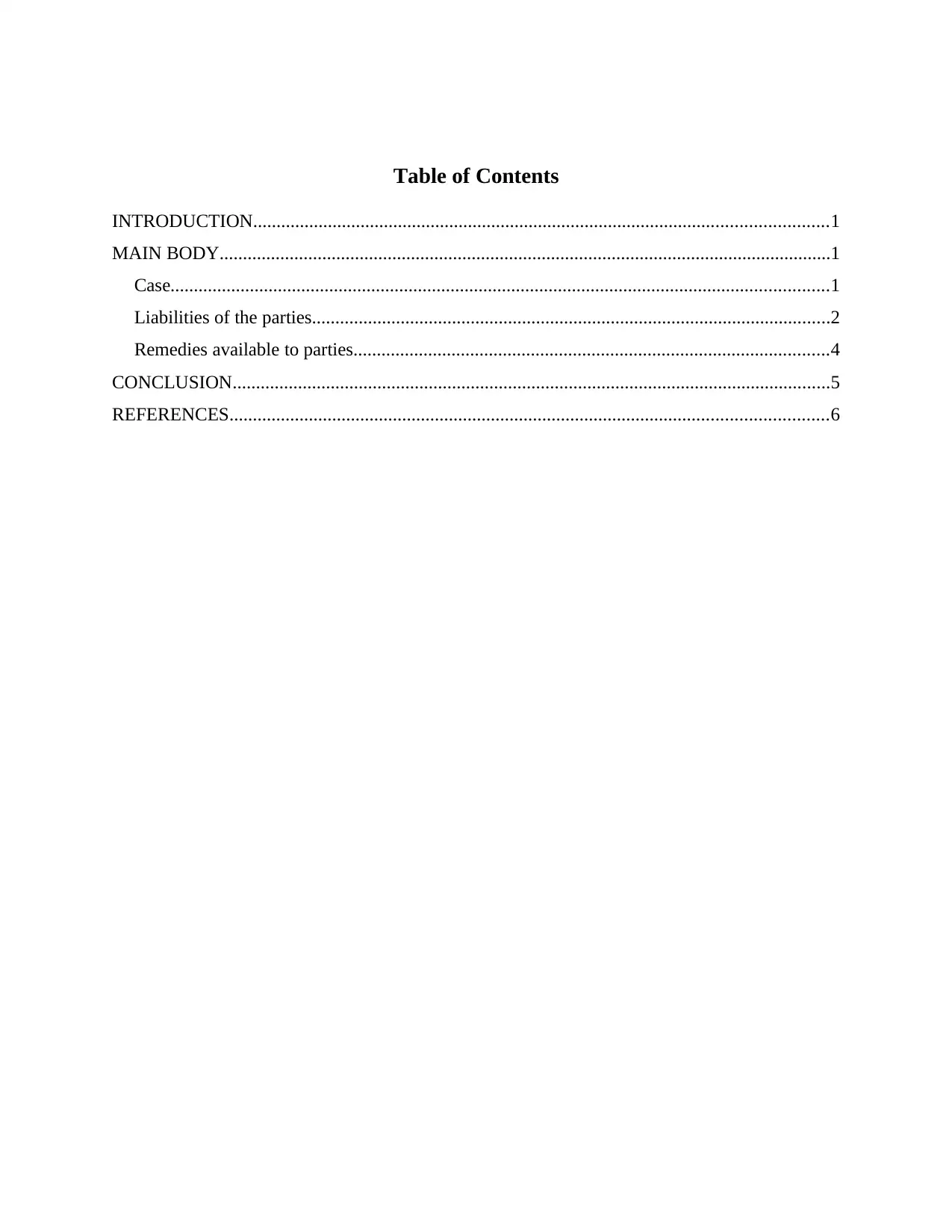
Table of Contents
INTRODUCTION...........................................................................................................................1
MAIN BODY...................................................................................................................................1
Case.............................................................................................................................................1
Liabilities of the parties...............................................................................................................2
Remedies available to parties......................................................................................................4
CONCLUSION................................................................................................................................5
REFERENCES................................................................................................................................6
INTRODUCTION...........................................................................................................................1
MAIN BODY...................................................................................................................................1
Case.............................................................................................................................................1
Liabilities of the parties...............................................................................................................2
Remedies available to parties......................................................................................................4
CONCLUSION................................................................................................................................5
REFERENCES................................................................................................................................6
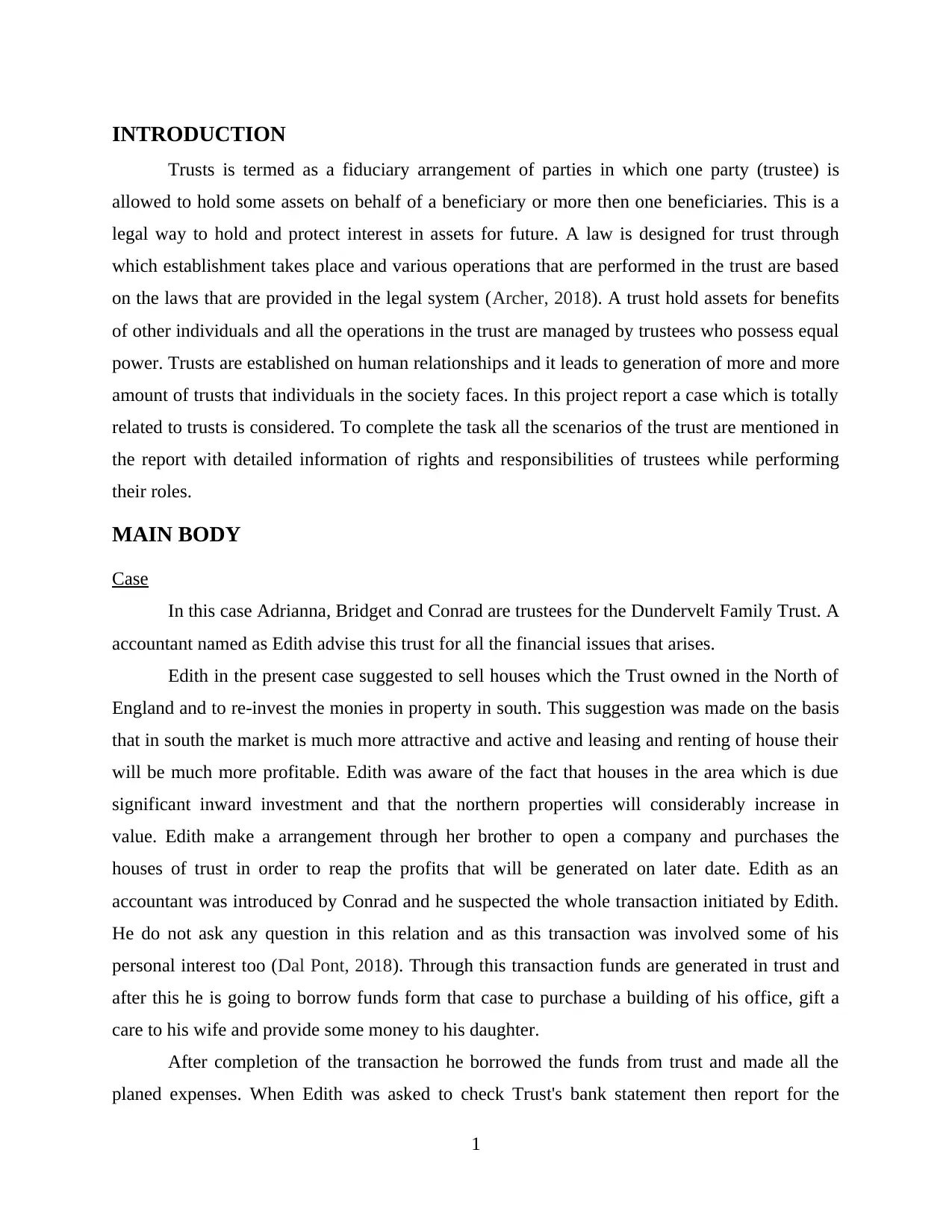
INTRODUCTION
Trusts is termed as a fiduciary arrangement of parties in which one party (trustee) is
allowed to hold some assets on behalf of a beneficiary or more then one beneficiaries. This is a
legal way to hold and protect interest in assets for future. A law is designed for trust through
which establishment takes place and various operations that are performed in the trust are based
on the laws that are provided in the legal system (Archer, 2018). A trust hold assets for benefits
of other individuals and all the operations in the trust are managed by trustees who possess equal
power. Trusts are established on human relationships and it leads to generation of more and more
amount of trusts that individuals in the society faces. In this project report a case which is totally
related to trusts is considered. To complete the task all the scenarios of the trust are mentioned in
the report with detailed information of rights and responsibilities of trustees while performing
their roles.
MAIN BODY
Case
In this case Adrianna, Bridget and Conrad are trustees for the Dundervelt Family Trust. A
accountant named as Edith advise this trust for all the financial issues that arises.
Edith in the present case suggested to sell houses which the Trust owned in the North of
England and to re-invest the monies in property in south. This suggestion was made on the basis
that in south the market is much more attractive and active and leasing and renting of house their
will be much more profitable. Edith was aware of the fact that houses in the area which is due
significant inward investment and that the northern properties will considerably increase in
value. Edith make a arrangement through her brother to open a company and purchases the
houses of trust in order to reap the profits that will be generated on later date. Edith as an
accountant was introduced by Conrad and he suspected the whole transaction initiated by Edith.
He do not ask any question in this relation and as this transaction was involved some of his
personal interest too (Dal Pont, 2018). Through this transaction funds are generated in trust and
after this he is going to borrow funds form that case to purchase a building of his office, gift a
care to his wife and provide some money to his daughter.
After completion of the transaction he borrowed the funds from trust and made all the
planed expenses. When Edith was asked to check Trust's bank statement then report for the
1
Trusts is termed as a fiduciary arrangement of parties in which one party (trustee) is
allowed to hold some assets on behalf of a beneficiary or more then one beneficiaries. This is a
legal way to hold and protect interest in assets for future. A law is designed for trust through
which establishment takes place and various operations that are performed in the trust are based
on the laws that are provided in the legal system (Archer, 2018). A trust hold assets for benefits
of other individuals and all the operations in the trust are managed by trustees who possess equal
power. Trusts are established on human relationships and it leads to generation of more and more
amount of trusts that individuals in the society faces. In this project report a case which is totally
related to trusts is considered. To complete the task all the scenarios of the trust are mentioned in
the report with detailed information of rights and responsibilities of trustees while performing
their roles.
MAIN BODY
Case
In this case Adrianna, Bridget and Conrad are trustees for the Dundervelt Family Trust. A
accountant named as Edith advise this trust for all the financial issues that arises.
Edith in the present case suggested to sell houses which the Trust owned in the North of
England and to re-invest the monies in property in south. This suggestion was made on the basis
that in south the market is much more attractive and active and leasing and renting of house their
will be much more profitable. Edith was aware of the fact that houses in the area which is due
significant inward investment and that the northern properties will considerably increase in
value. Edith make a arrangement through her brother to open a company and purchases the
houses of trust in order to reap the profits that will be generated on later date. Edith as an
accountant was introduced by Conrad and he suspected the whole transaction initiated by Edith.
He do not ask any question in this relation and as this transaction was involved some of his
personal interest too (Dal Pont, 2018). Through this transaction funds are generated in trust and
after this he is going to borrow funds form that case to purchase a building of his office, gift a
care to his wife and provide some money to his daughter.
After completion of the transaction he borrowed the funds from trust and made all the
planed expenses. When Edith was asked to check Trust's bank statement then report for the
1
⊘ This is a preview!⊘
Do you want full access?
Subscribe today to unlock all pages.

Trusted by 1+ million students worldwide
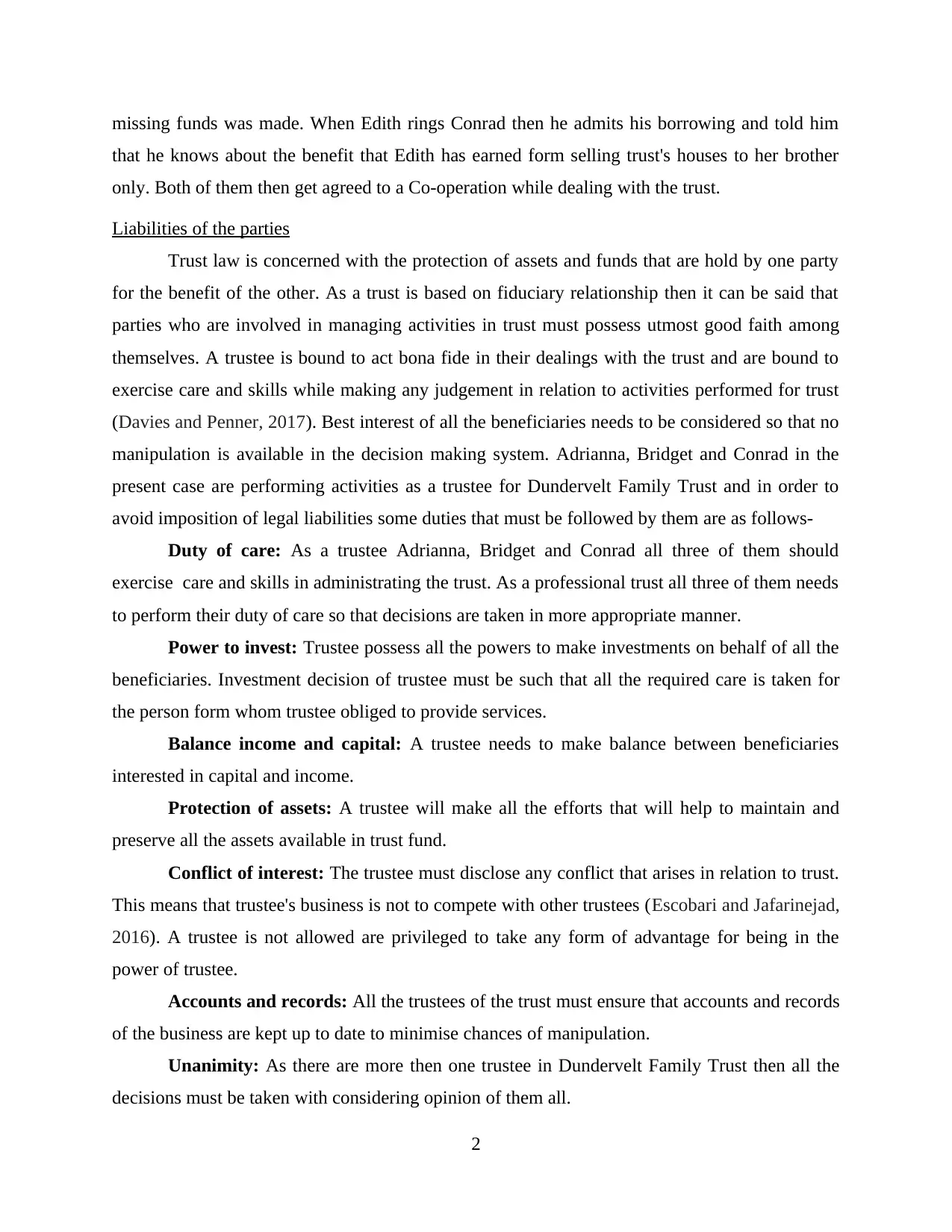
missing funds was made. When Edith rings Conrad then he admits his borrowing and told him
that he knows about the benefit that Edith has earned form selling trust's houses to her brother
only. Both of them then get agreed to a Co-operation while dealing with the trust.
Liabilities of the parties
Trust law is concerned with the protection of assets and funds that are hold by one party
for the benefit of the other. As a trust is based on fiduciary relationship then it can be said that
parties who are involved in managing activities in trust must possess utmost good faith among
themselves. A trustee is bound to act bona fide in their dealings with the trust and are bound to
exercise care and skills while making any judgement in relation to activities performed for trust
(Davies and Penner, 2017). Best interest of all the beneficiaries needs to be considered so that no
manipulation is available in the decision making system. Adrianna, Bridget and Conrad in the
present case are performing activities as a trustee for Dundervelt Family Trust and in order to
avoid imposition of legal liabilities some duties that must be followed by them are as follows-
Duty of care: As a trustee Adrianna, Bridget and Conrad all three of them should
exercise care and skills in administrating the trust. As a professional trust all three of them needs
to perform their duty of care so that decisions are taken in more appropriate manner.
Power to invest: Trustee possess all the powers to make investments on behalf of all the
beneficiaries. Investment decision of trustee must be such that all the required care is taken for
the person form whom trustee obliged to provide services.
Balance income and capital: A trustee needs to make balance between beneficiaries
interested in capital and income.
Protection of assets: A trustee will make all the efforts that will help to maintain and
preserve all the assets available in trust fund.
Conflict of interest: The trustee must disclose any conflict that arises in relation to trust.
This means that trustee's business is not to compete with other trustees (Escobari and Jafarinejad,
2016). A trustee is not allowed are privileged to take any form of advantage for being in the
power of trustee.
Accounts and records: All the trustees of the trust must ensure that accounts and records
of the business are kept up to date to minimise chances of manipulation.
Unanimity: As there are more then one trustee in Dundervelt Family Trust then all the
decisions must be taken with considering opinion of them all.
2
that he knows about the benefit that Edith has earned form selling trust's houses to her brother
only. Both of them then get agreed to a Co-operation while dealing with the trust.
Liabilities of the parties
Trust law is concerned with the protection of assets and funds that are hold by one party
for the benefit of the other. As a trust is based on fiduciary relationship then it can be said that
parties who are involved in managing activities in trust must possess utmost good faith among
themselves. A trustee is bound to act bona fide in their dealings with the trust and are bound to
exercise care and skills while making any judgement in relation to activities performed for trust
(Davies and Penner, 2017). Best interest of all the beneficiaries needs to be considered so that no
manipulation is available in the decision making system. Adrianna, Bridget and Conrad in the
present case are performing activities as a trustee for Dundervelt Family Trust and in order to
avoid imposition of legal liabilities some duties that must be followed by them are as follows-
Duty of care: As a trustee Adrianna, Bridget and Conrad all three of them should
exercise care and skills in administrating the trust. As a professional trust all three of them needs
to perform their duty of care so that decisions are taken in more appropriate manner.
Power to invest: Trustee possess all the powers to make investments on behalf of all the
beneficiaries. Investment decision of trustee must be such that all the required care is taken for
the person form whom trustee obliged to provide services.
Balance income and capital: A trustee needs to make balance between beneficiaries
interested in capital and income.
Protection of assets: A trustee will make all the efforts that will help to maintain and
preserve all the assets available in trust fund.
Conflict of interest: The trustee must disclose any conflict that arises in relation to trust.
This means that trustee's business is not to compete with other trustees (Escobari and Jafarinejad,
2016). A trustee is not allowed are privileged to take any form of advantage for being in the
power of trustee.
Accounts and records: All the trustees of the trust must ensure that accounts and records
of the business are kept up to date to minimise chances of manipulation.
Unanimity: As there are more then one trustee in Dundervelt Family Trust then all the
decisions must be taken with considering opinion of them all.
2
Paraphrase This Document
Need a fresh take? Get an instant paraphrase of this document with our AI Paraphraser
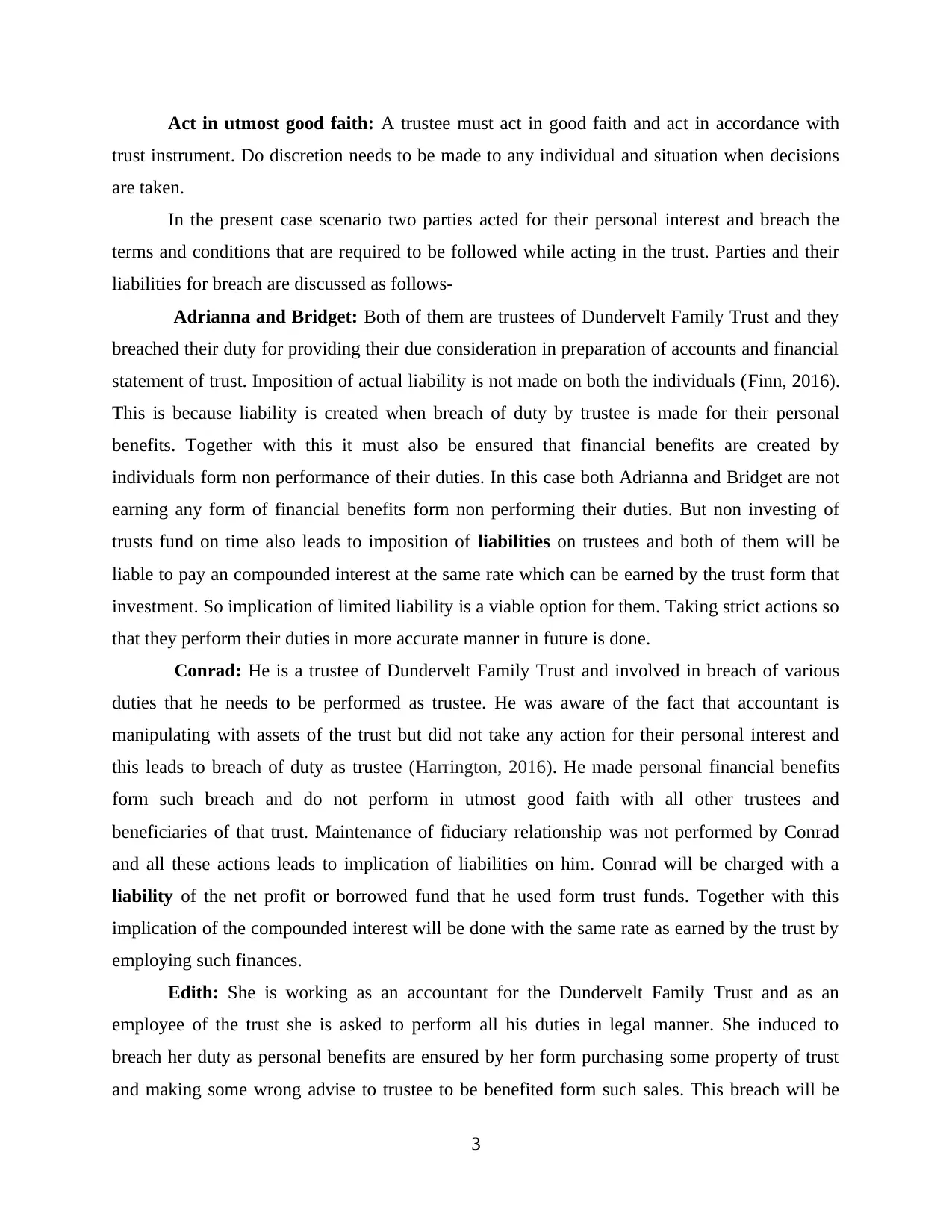
Act in utmost good faith: A trustee must act in good faith and act in accordance with
trust instrument. Do discretion needs to be made to any individual and situation when decisions
are taken.
In the present case scenario two parties acted for their personal interest and breach the
terms and conditions that are required to be followed while acting in the trust. Parties and their
liabilities for breach are discussed as follows-
Adrianna and Bridget: Both of them are trustees of Dundervelt Family Trust and they
breached their duty for providing their due consideration in preparation of accounts and financial
statement of trust. Imposition of actual liability is not made on both the individuals (Finn, 2016).
This is because liability is created when breach of duty by trustee is made for their personal
benefits. Together with this it must also be ensured that financial benefits are created by
individuals form non performance of their duties. In this case both Adrianna and Bridget are not
earning any form of financial benefits form non performing their duties. But non investing of
trusts fund on time also leads to imposition of liabilities on trustees and both of them will be
liable to pay an compounded interest at the same rate which can be earned by the trust form that
investment. So implication of limited liability is a viable option for them. Taking strict actions so
that they perform their duties in more accurate manner in future is done.
Conrad: He is a trustee of Dundervelt Family Trust and involved in breach of various
duties that he needs to be performed as trustee. He was aware of the fact that accountant is
manipulating with assets of the trust but did not take any action for their personal interest and
this leads to breach of duty as trustee (Harrington, 2016). He made personal financial benefits
form such breach and do not perform in utmost good faith with all other trustees and
beneficiaries of that trust. Maintenance of fiduciary relationship was not performed by Conrad
and all these actions leads to implication of liabilities on him. Conrad will be charged with a
liability of the net profit or borrowed fund that he used form trust funds. Together with this
implication of the compounded interest will be done with the same rate as earned by the trust by
employing such finances.
Edith: She is working as an accountant for the Dundervelt Family Trust and as an
employee of the trust she is asked to perform all his duties in legal manner. She induced to
breach her duty as personal benefits are ensured by her form purchasing some property of trust
and making some wrong advise to trustee to be benefited form such sales. This breach will be
3
trust instrument. Do discretion needs to be made to any individual and situation when decisions
are taken.
In the present case scenario two parties acted for their personal interest and breach the
terms and conditions that are required to be followed while acting in the trust. Parties and their
liabilities for breach are discussed as follows-
Adrianna and Bridget: Both of them are trustees of Dundervelt Family Trust and they
breached their duty for providing their due consideration in preparation of accounts and financial
statement of trust. Imposition of actual liability is not made on both the individuals (Finn, 2016).
This is because liability is created when breach of duty by trustee is made for their personal
benefits. Together with this it must also be ensured that financial benefits are created by
individuals form non performance of their duties. In this case both Adrianna and Bridget are not
earning any form of financial benefits form non performing their duties. But non investing of
trusts fund on time also leads to imposition of liabilities on trustees and both of them will be
liable to pay an compounded interest at the same rate which can be earned by the trust form that
investment. So implication of limited liability is a viable option for them. Taking strict actions so
that they perform their duties in more accurate manner in future is done.
Conrad: He is a trustee of Dundervelt Family Trust and involved in breach of various
duties that he needs to be performed as trustee. He was aware of the fact that accountant is
manipulating with assets of the trust but did not take any action for their personal interest and
this leads to breach of duty as trustee (Harrington, 2016). He made personal financial benefits
form such breach and do not perform in utmost good faith with all other trustees and
beneficiaries of that trust. Maintenance of fiduciary relationship was not performed by Conrad
and all these actions leads to implication of liabilities on him. Conrad will be charged with a
liability of the net profit or borrowed fund that he used form trust funds. Together with this
implication of the compounded interest will be done with the same rate as earned by the trust by
employing such finances.
Edith: She is working as an accountant for the Dundervelt Family Trust and as an
employee of the trust she is asked to perform all his duties in legal manner. She induced to
breach her duty as personal benefits are ensured by her form purchasing some property of trust
and making some wrong advise to trustee to be benefited form such sales. This breach will be
3
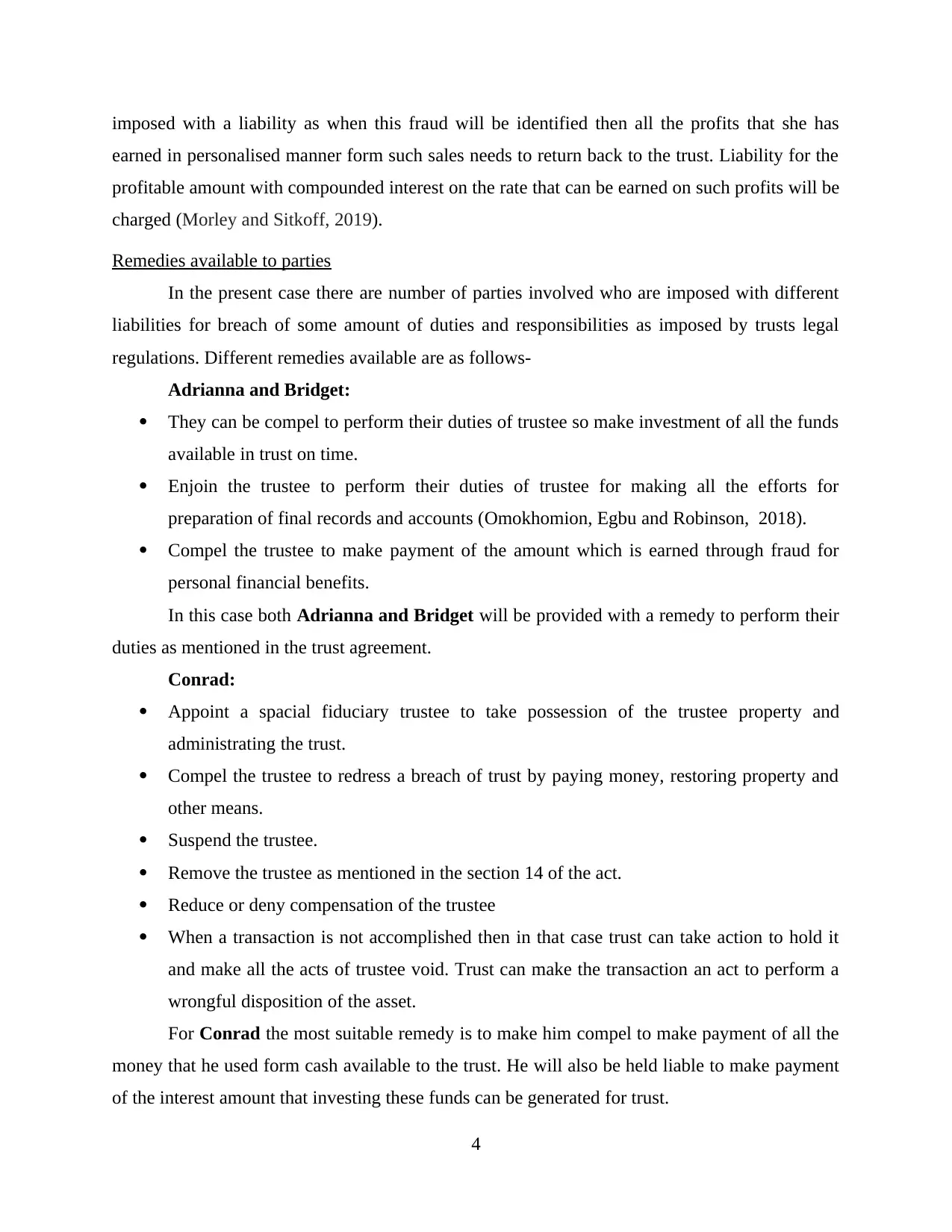
imposed with a liability as when this fraud will be identified then all the profits that she has
earned in personalised manner form such sales needs to return back to the trust. Liability for the
profitable amount with compounded interest on the rate that can be earned on such profits will be
charged (Morley and Sitkoff, 2019).
Remedies available to parties
In the present case there are number of parties involved who are imposed with different
liabilities for breach of some amount of duties and responsibilities as imposed by trusts legal
regulations. Different remedies available are as follows-
Adrianna and Bridget:
They can be compel to perform their duties of trustee so make investment of all the funds
available in trust on time.
Enjoin the trustee to perform their duties of trustee for making all the efforts for
preparation of final records and accounts (Omokhomion, Egbu and Robinson, 2018).
Compel the trustee to make payment of the amount which is earned through fraud for
personal financial benefits.
In this case both Adrianna and Bridget will be provided with a remedy to perform their
duties as mentioned in the trust agreement.
Conrad:
Appoint a spacial fiduciary trustee to take possession of the trustee property and
administrating the trust.
Compel the trustee to redress a breach of trust by paying money, restoring property and
other means.
Suspend the trustee.
Remove the trustee as mentioned in the section 14 of the act.
Reduce or deny compensation of the trustee
When a transaction is not accomplished then in that case trust can take action to hold it
and make all the acts of trustee void. Trust can make the transaction an act to perform a
wrongful disposition of the asset.
For Conrad the most suitable remedy is to make him compel to make payment of all the
money that he used form cash available to the trust. He will also be held liable to make payment
of the interest amount that investing these funds can be generated for trust.
4
earned in personalised manner form such sales needs to return back to the trust. Liability for the
profitable amount with compounded interest on the rate that can be earned on such profits will be
charged (Morley and Sitkoff, 2019).
Remedies available to parties
In the present case there are number of parties involved who are imposed with different
liabilities for breach of some amount of duties and responsibilities as imposed by trusts legal
regulations. Different remedies available are as follows-
Adrianna and Bridget:
They can be compel to perform their duties of trustee so make investment of all the funds
available in trust on time.
Enjoin the trustee to perform their duties of trustee for making all the efforts for
preparation of final records and accounts (Omokhomion, Egbu and Robinson, 2018).
Compel the trustee to make payment of the amount which is earned through fraud for
personal financial benefits.
In this case both Adrianna and Bridget will be provided with a remedy to perform their
duties as mentioned in the trust agreement.
Conrad:
Appoint a spacial fiduciary trustee to take possession of the trustee property and
administrating the trust.
Compel the trustee to redress a breach of trust by paying money, restoring property and
other means.
Suspend the trustee.
Remove the trustee as mentioned in the section 14 of the act.
Reduce or deny compensation of the trustee
When a transaction is not accomplished then in that case trust can take action to hold it
and make all the acts of trustee void. Trust can make the transaction an act to perform a
wrongful disposition of the asset.
For Conrad the most suitable remedy is to make him compel to make payment of all the
money that he used form cash available to the trust. He will also be held liable to make payment
of the interest amount that investing these funds can be generated for trust.
4
⊘ This is a preview!⊘
Do you want full access?
Subscribe today to unlock all pages.

Trusted by 1+ million students worldwide
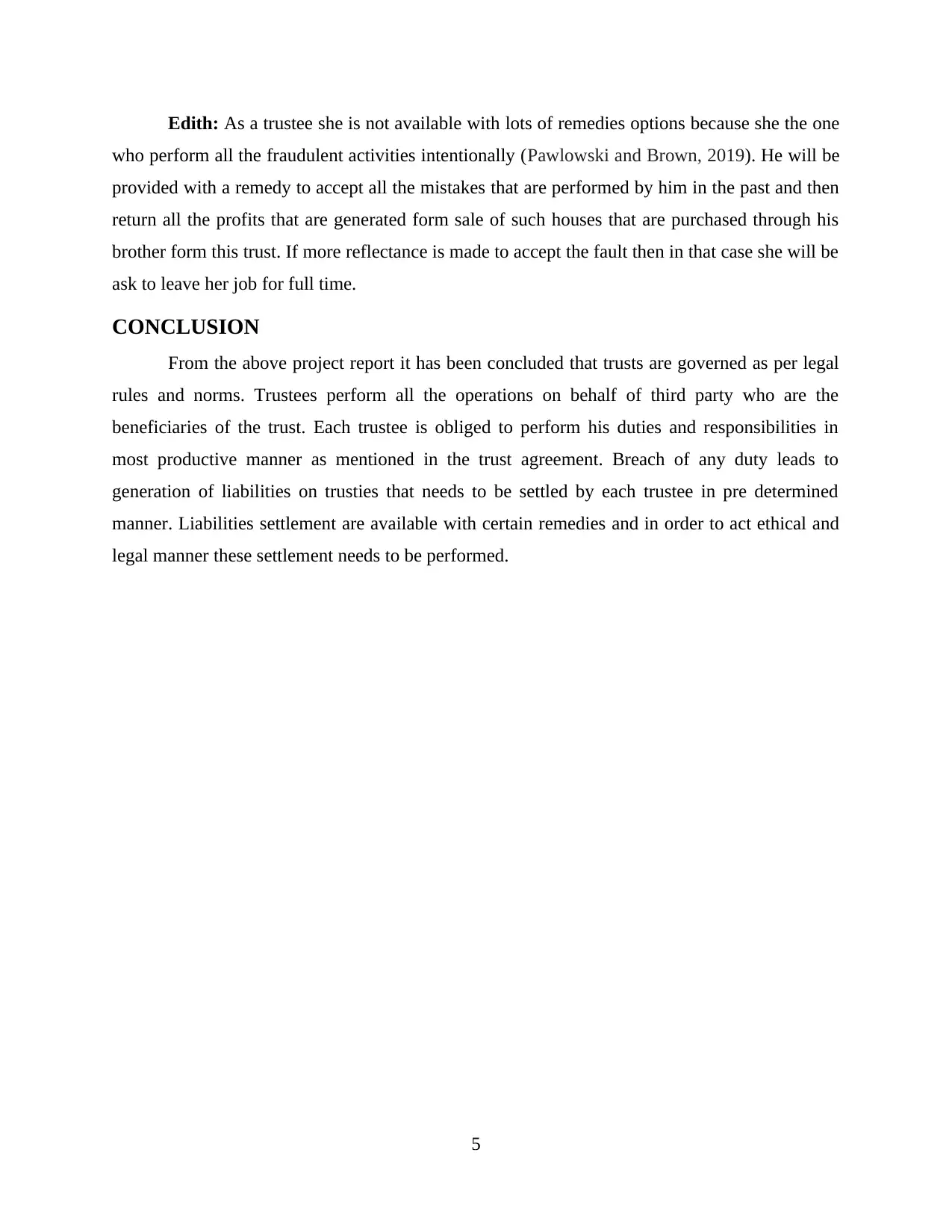
Edith: As a trustee she is not available with lots of remedies options because she the one
who perform all the fraudulent activities intentionally (Pawlowski and Brown, 2019). He will be
provided with a remedy to accept all the mistakes that are performed by him in the past and then
return all the profits that are generated form sale of such houses that are purchased through his
brother form this trust. If more reflectance is made to accept the fault then in that case she will be
ask to leave her job for full time.
CONCLUSION
From the above project report it has been concluded that trusts are governed as per legal
rules and norms. Trustees perform all the operations on behalf of third party who are the
beneficiaries of the trust. Each trustee is obliged to perform his duties and responsibilities in
most productive manner as mentioned in the trust agreement. Breach of any duty leads to
generation of liabilities on trusties that needs to be settled by each trustee in pre determined
manner. Liabilities settlement are available with certain remedies and in order to act ethical and
legal manner these settlement needs to be performed.
5
who perform all the fraudulent activities intentionally (Pawlowski and Brown, 2019). He will be
provided with a remedy to accept all the mistakes that are performed by him in the past and then
return all the profits that are generated form sale of such houses that are purchased through his
brother form this trust. If more reflectance is made to accept the fault then in that case she will be
ask to leave her job for full time.
CONCLUSION
From the above project report it has been concluded that trusts are governed as per legal
rules and norms. Trustees perform all the operations on behalf of third party who are the
beneficiaries of the trust. Each trustee is obliged to perform his duties and responsibilities in
most productive manner as mentioned in the trust agreement. Breach of any duty leads to
generation of liabilities on trusties that needs to be settled by each trustee in pre determined
manner. Liabilities settlement are available with certain remedies and in order to act ethical and
legal manner these settlement needs to be performed.
5
Paraphrase This Document
Need a fresh take? Get an instant paraphrase of this document with our AI Paraphraser
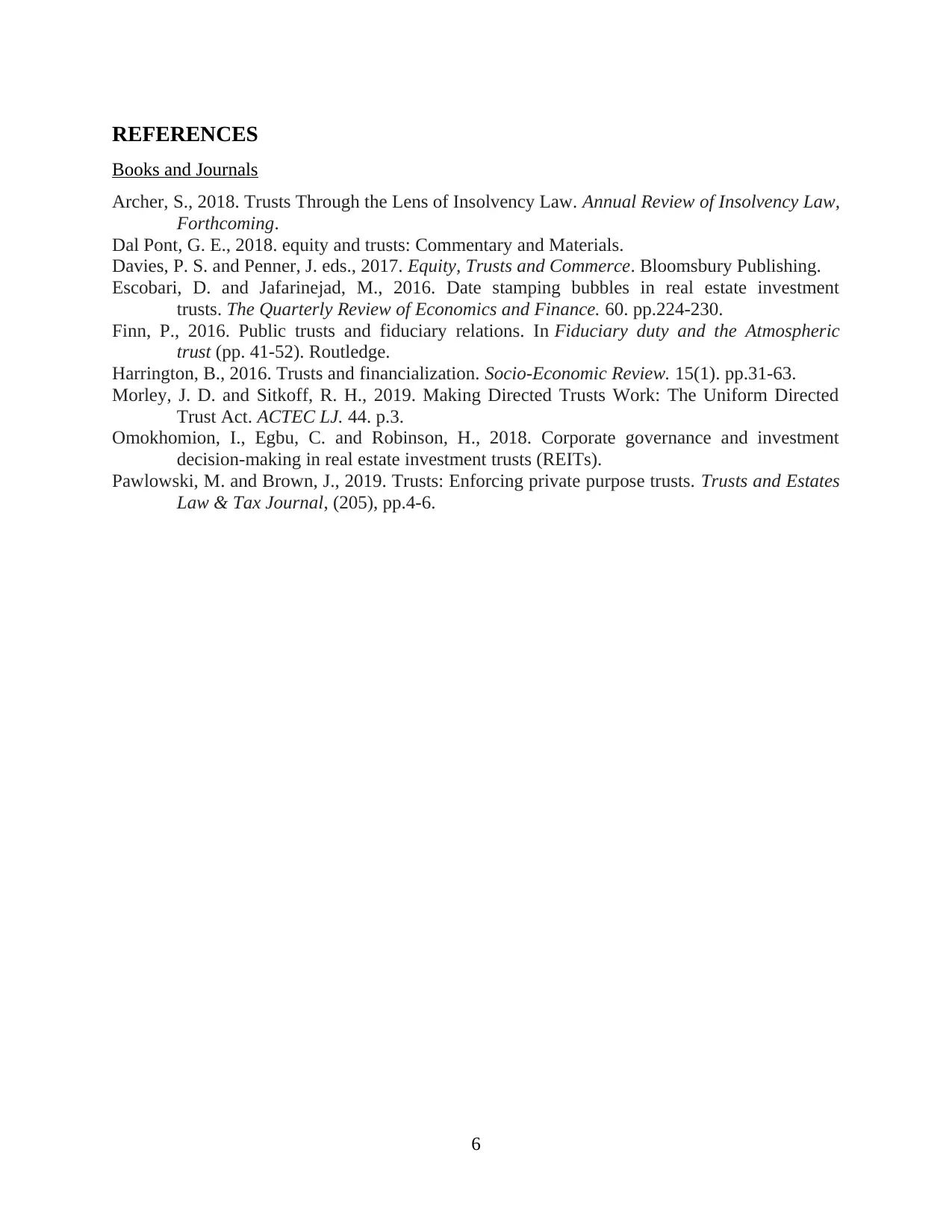
REFERENCES
Books and Journals
Archer, S., 2018. Trusts Through the Lens of Insolvency Law. Annual Review of Insolvency Law,
Forthcoming.
Dal Pont, G. E., 2018. equity and trusts: Commentary and Materials.
Davies, P. S. and Penner, J. eds., 2017. Equity, Trusts and Commerce. Bloomsbury Publishing.
Escobari, D. and Jafarinejad, M., 2016. Date stamping bubbles in real estate investment
trusts. The Quarterly Review of Economics and Finance. 60. pp.224-230.
Finn, P., 2016. Public trusts and fiduciary relations. In Fiduciary duty and the Atmospheric
trust (pp. 41-52). Routledge.
Harrington, B., 2016. Trusts and financialization. Socio-Economic Review. 15(1). pp.31-63.
Morley, J. D. and Sitkoff, R. H., 2019. Making Directed Trusts Work: The Uniform Directed
Trust Act. ACTEC LJ. 44. p.3.
Omokhomion, I., Egbu, C. and Robinson, H., 2018. Corporate governance and investment
decision-making in real estate investment trusts (REITs).
Pawlowski, M. and Brown, J., 2019. Trusts: Enforcing private purpose trusts. Trusts and Estates
Law & Tax Journal, (205), pp.4-6.
6
Books and Journals
Archer, S., 2018. Trusts Through the Lens of Insolvency Law. Annual Review of Insolvency Law,
Forthcoming.
Dal Pont, G. E., 2018. equity and trusts: Commentary and Materials.
Davies, P. S. and Penner, J. eds., 2017. Equity, Trusts and Commerce. Bloomsbury Publishing.
Escobari, D. and Jafarinejad, M., 2016. Date stamping bubbles in real estate investment
trusts. The Quarterly Review of Economics and Finance. 60. pp.224-230.
Finn, P., 2016. Public trusts and fiduciary relations. In Fiduciary duty and the Atmospheric
trust (pp. 41-52). Routledge.
Harrington, B., 2016. Trusts and financialization. Socio-Economic Review. 15(1). pp.31-63.
Morley, J. D. and Sitkoff, R. H., 2019. Making Directed Trusts Work: The Uniform Directed
Trust Act. ACTEC LJ. 44. p.3.
Omokhomion, I., Egbu, C. and Robinson, H., 2018. Corporate governance and investment
decision-making in real estate investment trusts (REITs).
Pawlowski, M. and Brown, J., 2019. Trusts: Enforcing private purpose trusts. Trusts and Estates
Law & Tax Journal, (205), pp.4-6.
6
1 out of 8
Related Documents
Your All-in-One AI-Powered Toolkit for Academic Success.
+13062052269
info@desklib.com
Available 24*7 on WhatsApp / Email
![[object Object]](/_next/static/media/star-bottom.7253800d.svg)
Unlock your academic potential
Copyright © 2020–2025 A2Z Services. All Rights Reserved. Developed and managed by ZUCOL.





